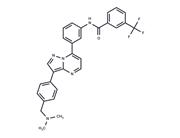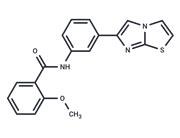| Name | Ricolinostat |
| Description | Ricolinostat (Rocilinostat) is an orally bioavailable, specific inhibitor of histone deacetylase 6 (HDAC6) with potential antineoplastic activity. |
| Cell Research | ACY-1215 is dissolved in DMSO (10 mM) and stored, and then in diluted with appropriate culture medium before use[1]. The effect of ACY-1215 with or without Bortezomib on the viability of MM cell lines, patient MM cells, and PBMCs is assessed by measuring MTT dye absorbance. PBMCs from healthy donors are isolated and stimulated with 2.5 μg/mL of phytohemagglutinin (PHA) for 48 hours in the presence of increasing concentrations of ACY-1215. DNA synthesis is measured by tritiated thymidine uptake. CD4+ T cells are purified from human blood with the Rosette Sep negative-selection kit. Cells are stimulated by CD3/CD28 Dynabeads for 7 days in the presence of compounds. Cell viability is assessed using alamarBlue. MM cells (2-3×104 cells/well) are incubated in 96-well culture plates with medium and different concentrations of ACY-1215, Bortezomib, and/or recombinant IL-6 (10 ng/mL) or insulin-like growth factor-1 (IGF-1; 50 ng/mL) for 24 hours at 37°C, and tritiated thymidine incorporation is measured[1]. |
| Kinase Assay | ACY-1215 is dissolved and subsequently diluted in assay buffer [50 mM HEPES, pH 7.4, 100 mM KCl, 0.001% Tween-20, 0.05% BSA, and 20 μM tris(2-carboxyethyl)phosphine] to 6-fold the final concentration. HDAC enzymes are diluted to 1.5-fold of the final concentration in assay buffer and pre-incubated with ACY-1215 for 10 minutes before the addition of the substrate. The amount of FTS (HDAC1, HDAC2, HDAC3, and HDAC6) or MAZ-1675 (HDAC4, HDAC5, HDAC7, HDAC8, and HDAC9) used for each enzyme is equal to the Michaelis constant (Km), as determined by a titration curve. FTS or MAZ-1675 is diluted in assay buffer to 6-fold the final concentration with 0.3 μM sequencing grade trypsin. The substrate/trypsin mix is added to the enzyme/compound mix and the plate is shaken for 60 seconds and then placed into a SpectraMax M5 microtiter plate reader. The enzymatic reaction is monitored for release of 7-amino-4-methoxy-coumarin over 30 minutes, after deacetylation of the lysine side chain in the peptide substrate, and the linear rate of the reaction is calculated[1]. |
| In vitro | ACY-1215 is readily absorbed by tumor tissues and does not accumulate within them in both multiple myeloma models and diffuse MM models, effectively inhibiting tumor growth. |
| In vivo | ACY-1215, at very low dosages, significantly induces acetylation of α-tubulin while at higher dosages, it leads to the acetylation of lysine residues on histone proteins H3 and H4. ACY-1215 demonstrates slight activity against HDAC4, HDAC5, HDAC7, HDAC9, HDAC11, Sirtuin1, and Sirtuin2, with an IC50 of 0.1 μM specifically for HDAC8. |
| Storage | Powder: -20°C for 3 years | In solvent: -80°C for 1 year | Shipping with blue ice. |
| Solubility Information | Ethanol : < 1 mg/mL (insoluble or slightly soluble)
DMSO : 50 mg/mL (115.34 mM)
|
| Keywords | inhibit | Ricolinostat | ACY 1215 | HDAC | ACY1215 | Inhibitor | Apoptosis | Histone deacetylases |
| Inhibitors Related | Stavudine | 5-Fluorouracil | Acetylcysteine | Kaempferol | Myricetin | Sodium 4-phenylbutyrate | L-Ascorbic acid | Dextran sulfate sodium salt (MW 4500-5500) | Metronidazole | Sorafenib | Tributyrin | Curcumin |
| Related Compound Libraries | Bioactive Compound Library | Cancer Cell Differentiation Compound Library | Chromatin Modification Compound Library | Anti-Cancer Clinical Compound Library | Drug Repurposing Compound Library | Inhibitor Library | Anti-Aging Compound Library | Bioactive Compounds Library Max | Anti-Cancer Drug Library | Anti-Cancer Active Compound Library |

 United States
United States



